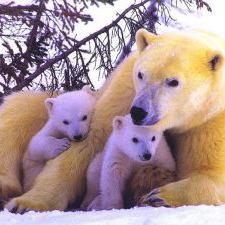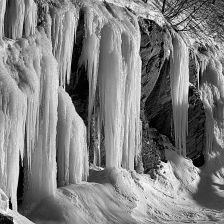 With tourist traffic increasing dramatically to the Arctic and Antarctic, is it time to say “bye, polar?”
With tourist traffic increasing dramatically to the Arctic and Antarctic, is it time to say “bye, polar?”
Or can tourism be a boost to the farthest reaches of the planet?
According to Virtuous Traveler Leslie Garrett, the answer in this International Polar Year seems to depend on a light touch…
It seems that suddenly, the polar bear and the penguin have become the poster animals for reducing climate change. And as any Hollywood star will tell you, with increased fame comes increased scrutiny. This has certainly been the case for the homes of these two creatures.
While the Polar Regions have largely been the frontier of explorers and extreme adventure seekers, these days it’s as likely to be your dentist or your babysitter who’s planning a polar expedition. Never before has such attention been focused on the Arctic and Antarctic regions — and never before have so many people been inspired to see each destination first-hand.
Of course, much of this is the result of penguin and polar fever, thanks to certain documentaries and animated offerings. And some can be attributed to the dire warnings of scientists and climate change experts who are sounding the alarm over the melting of the polar ice caps. While the intent is to spur us to cut our greenhouse gas emissions, for some, it has prompted a “see-it-before-it’s-too-late” race to the poles. But what is the effect of all of this on the environment?
Plenty, according to some. It’s the increase in the number of cruise ships, among other things, in the Antarctic region that has some environmentalists concerned.
“There has been a massive increase in tourism shipping activity,” says Dr. Alan Hemmings, Environmental Consultant, Polar Regions, with the Antarctic and Southern Ocean Coalition (ASOC), which represents 150 conservation organizations in 40 countries. “More ships, more trips by ships, bigger ships…”
He’s worried not only about the environmental implications of this increased boat traffic, but also for safety and capacity to respond to boats in distress. He points to this past summer in which a boat, non-ice strengthened, he says, arrived carrying 3,700 people.
“Those 3,700 people were more than you would find ashore at all the Antarctic stations combined at high summer… so how on earth we should have rescued them, or accommodated them if we got them ashore is anyone’s guess.” He believes it’s a matter of time before this hypothetical situation becomes reality.
Ricardo Roura, Coordinator of ASOC’s Tourism and Protocol Implementation campaigns, is concerned about the devaluing of scientific priority in the Antarctic as tourism gains a stronghold. He says science and conservation have a priority under the Antarctic Treaty System, but “it may be difficult to carry out field work with a constant flow of tourists.”
A recent spate of news reports pronounced a “polar crisis” brought on by mass tourism. But while the news seemed dire, speaking with those who’ve been to either — or both — Polar Regions, offers some reassurance. It seems that rumors of the regions’ premature death may be greatly exaggerated.
Daniel Wood, a devoted traveler and award-winning journalist for Canadian Geographic, has seen more than 100 countries, and has just returned from a kayaking expedition to Ellesmere Island, a stone’s throw from Greenland and “north of 80,” as he puts it (anything north of 80 degrees latitude is considered polar).
“The idea that tourism is wreaking havoc on the Polar Regions is far-fetched,” he states. “[It’s] the shrill whine of the few that prefer their nature unpeopled. Or [those] who have been there and don’t want others to follow or join them.”
 And that would be a shame, believes Geoff Green, who founded and operates the innovative Students On Ice, a program that handpicks students from around the world and takes them to the Arctic and Antarctic. These two regions, he says, “are the windows to the world. They’re the cornerstones of our global ecosystem.”
And that would be a shame, believes Geoff Green, who founded and operates the innovative Students On Ice, a program that handpicks students from around the world and takes them to the Arctic and Antarctic. These two regions, he says, “are the windows to the world. They’re the cornerstones of our global ecosystem.”
Green, a former teacher who has been leading tourist expeditions to both areas for 15 years, was motivated to begin taking students when he saw the profound impact the areas had on adults — “jaded and cynical adults,” he points out. “I saw their perspectives being challenged,” he explains. “The Arctic and Antarctic are the greatest classrooms on earth…environmental issues, culture, history, all the sciences. We want the future leaders of the world concerned about and aware of [the issues].”
But what about the issues that increased tourism may raise?
Green has seen a huge boost in the numbers of tourists in the decade and a half that he’s been going to the Antarctic, from roughly 4,000 annually then to 25,000 now. Wood says the first cruise ship to Resolute Bay arrived the day his kayaking group left. “Because of global warming,” he says, “the ice has gone out.”
In other words, these massive boats can now access north of 80.
Even Hemmings and Roura admit that, thus far, there’s little obvious impact from tourism specifically to sites; however, Roura notes that there’s also been little monitoring of the situation. “In addition, in some sites, tourism may not be a primary cause of impact, but may have a tipping effect on communities that are already stressed for other reasons [such as] climatic conditions, lack of available food, etc.”
The Arctic is a different scenario in that it stretches over a much wider area and has a large number of disparate communities to consider. This human aspect, says Daniel Wood, makes Arctic tourism a “mixed blessing.” In most cases, he points out, it brings much-needed money into communities in the north. Dr Peter Ewins, director of Species Conservation with World Wildlife Fund (WWF) Canada, who has led Arctic cruises with the WWF, explains that, “without demonstrated revenues from tourism, local people wouldn’t be significantly motivated to protect those resources in the face of other interests.”
 Ewins points not only to the financial incentives to the Inuit people to protect their resources, but also to the increased number of tourists traveling to see the polar bears, which he believes motivates people to protect the polar ice caps by reducing climate change. “I do see positive benefits to taking people to the only intact ecosystems on the planet. It’s a good thing in terms of getting people out of their armchairs and to be motivated — to talk with friends, get worked up, talk to politicians.”
Ewins points not only to the financial incentives to the Inuit people to protect their resources, but also to the increased number of tourists traveling to see the polar bears, which he believes motivates people to protect the polar ice caps by reducing climate change. “I do see positive benefits to taking people to the only intact ecosystems on the planet. It’s a good thing in terms of getting people out of their armchairs and to be motivated — to talk with friends, get worked up, talk to politicians.”
They key, he insists, is tourism that is properly managed.
And Ewins believes that is largely the case in the Arctic. Travel to the Arctic, he says, is subject to the “same principles and the same challenges” as its southern counterpoint. He claims that Arctic tour operators, at least 99.9% of them, operate responsibly.
And Green believes that tour operators are constantly striving to do better. “As the numbers grow, we have to adapt,” he says, “to change policy to continue to have a positive impact.” Antarctica seems well protected by the principles of the International Association of Antarctic Tour Operators (IAATO), which are borne of recommendations from the Antarctic Treaty. Any organization must do a full environmental evaluation, which must be approved by its home country. Geoff Green believes that the consistent scrutiny of tourism to the poles is a good thing. “Tourism has always been under the microscope in the Antarctic,” he says. “It’s not a free for all.”
Not yet, anyway, cautions Dr. Hemmings. “The tourism industry has emerged as a significant political and economic force and is exerting ever greater pressure in the Antarctic Treaty Meetings — to the detriment of other values,” he says. “Tourism is normalizing commercial imperatives within the Antarctic political regime, and thus increasingly challenging the ‘continent-for-science’ norm.”
In other words, money, it seems, talks. Even at the bottom of the world.
What Hemmings and the ASOC would like to see is limits put on tourism: caps on the number of visitors allowed, an agreement to not build hotels and airstrips ashore, an end to extremely large vessels in the waters. What’s more, Hemmings states, these restrictions need to be part of a legally binding measure, something ASOC is hoping they’re moving closer to achieving through the Antarctic Treaty System.
Daniel Wood is loathe to abandon travel altogether to these far-flung places “We run the risk of going into environmental fundamentalism,” he says. “It doesn’t allow much latitude.”
He insists that the answer for both Polar Regions, as with travel around the globe, lies in “not do we travel, but how do we make sure that we have minimal impact.”
“The world’s going to change and keep changing,” he promises, and “we need to minimize the damage.” Speaking as someone who has returned from an area that he describes as “looking more like Mars than Planet Earth,” he speaks apocalyptically of the tourism boom he anticipates.
“It’s going to come. We can wring our hands, but that’s the future.”
For more information, please visit:
https://www.asoc.org – Antarctic and Southern Oceans Coalition
https://www.studentsonice.com – Students on Ice
https://www.iaato.org – International Association of Antarctic Tour Operators
Leslie Garrett is an award-winning journalist and author of 13 books, including The Virtuous Consumer: Your Essential Shopping Guide to a Better, Kinder, Healthier Planet (June 2007). Visit her at https://www.thevirtuoustraveler.com.
For more Responsible Travel Tips, click here.
Previously by Leslie Garrett on PeterGreenberg.com:
Eco-Oakland: The City You Only Thought You Knew
Chicago: More Green Than Meets the Eye
The Good, The Green and the Downright Crazy Tours
A Convention with Conviction: Greening Your Business Meetings












